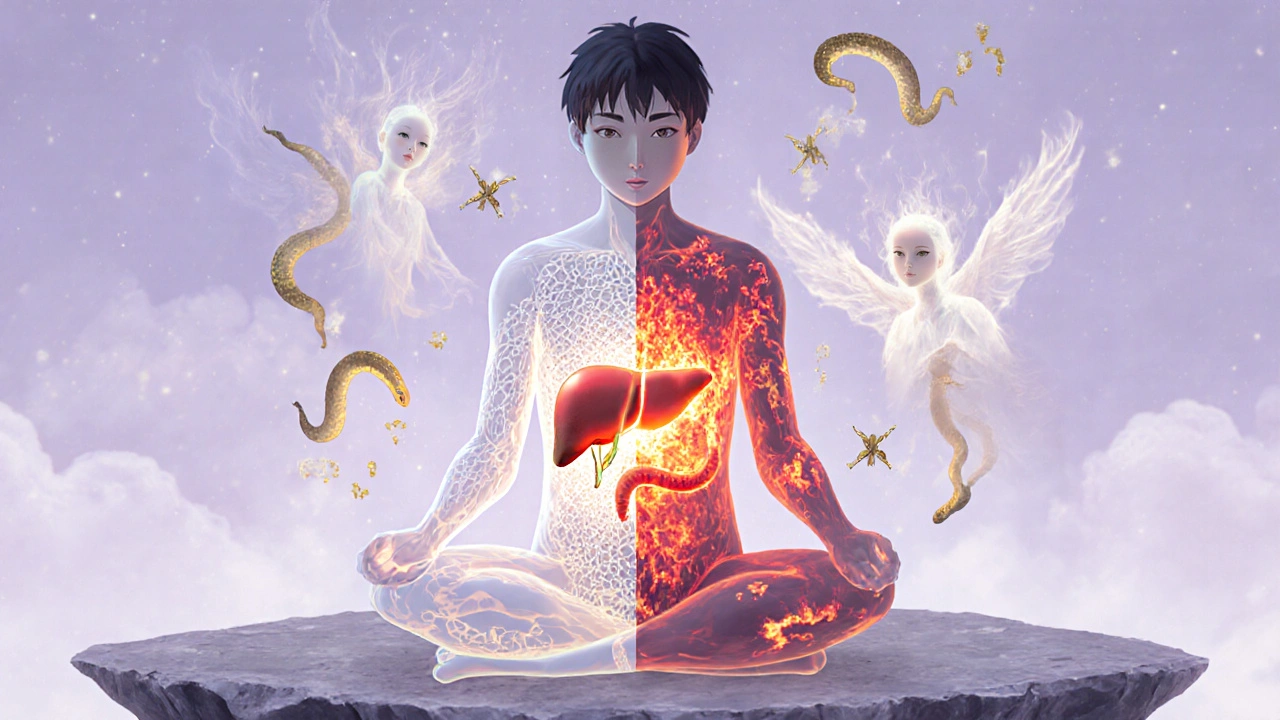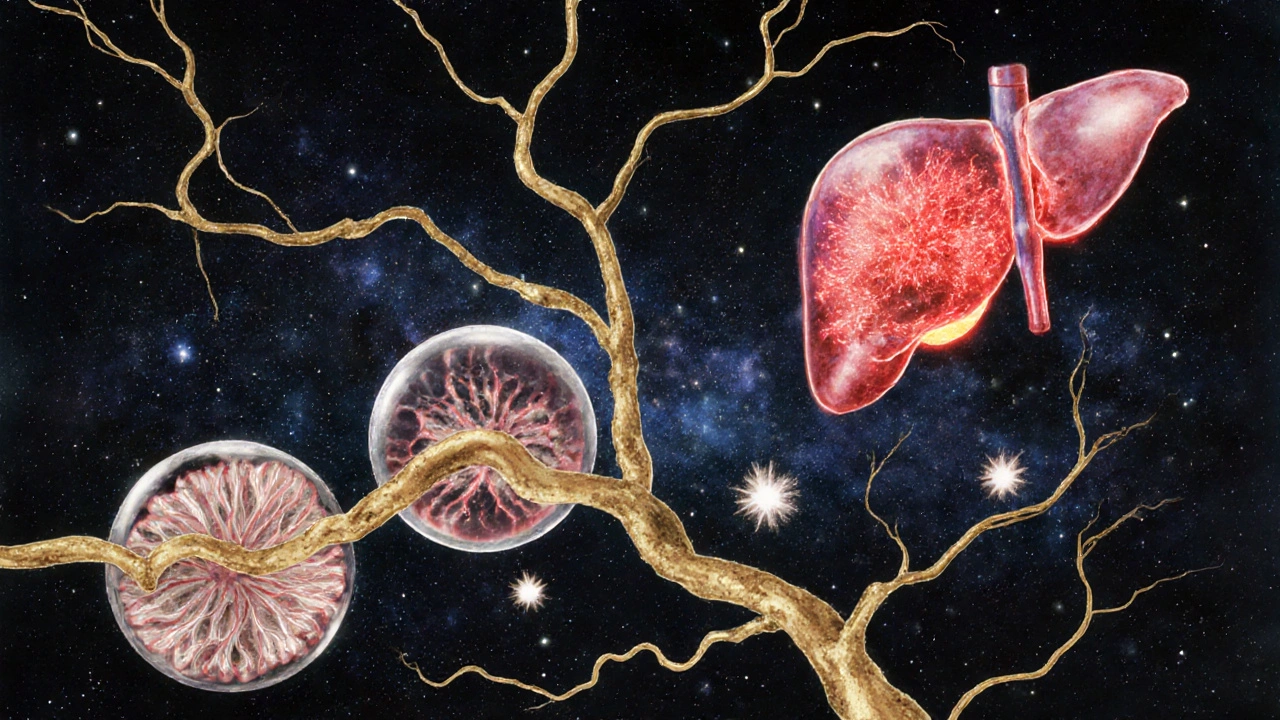When your liver starts acting up, it’s easy to assume it’s just one problem - maybe fatty liver, maybe hepatitis. But sometimes, the signs don’t fit neatly into one box. You might have high liver enzymes, fatigue, and itching - classic signs of autoimmune liver disease - but the pattern doesn’t match just one condition. That’s when doctors start looking at overlap syndromes: when features of Primary Biliary Cholangitis (PBC), Primary Sclerosing Cholangitis (PSC), and Autoimmune Hepatitis (AIH) show up together.
What Exactly Is an Autoimmune Overlap Syndrome?
An overlap syndrome isn’t a separate disease. It’s when a person shows clear signs of two autoimmune liver diseases at once. The most common combo is AIH and PBC. Less often, you’ll see AIH with PSC. True PBC and PSC overlap? That’s still debated. Most experts say it doesn’t really exist as a distinct entity - even though a few case reports claim otherwise.
Think of it like this: your immune system is supposed to protect you. In autoimmune diseases, it turns on your own body. In PBC, it attacks the small bile ducts inside the liver. In AIH, it targets liver cells themselves. In PSC, it inflames and scars the larger bile ducts, both inside and outside the liver. When two of these attacks happen at the same time, the symptoms, blood tests, and even liver biopsies get messy.
How Do You Tell Them Apart?
Each disease has its own fingerprint - but when they overlap, those fingerprints blur.
- AIH usually shows up with high ALT and AST (liver cell damage), elevated IgG, and autoantibodies like ANA or SMA. A liver biopsy will show interface hepatitis - immune cells eating away at the edge of liver lobules.
- PBC is marked by high ALP and GGT (bile duct damage), elevated IgM, and - here’s the key - anti-mitochondrial antibodies (AMA) in 90-95% of cases. Biopsy shows destruction of small bile ducts.
- PSC also raises ALP and GGT, but it’s often linked to inflammatory bowel disease (like ulcerative colitis). Biopsies show a "onion-skin" fibrosis around bile ducts. MRI or ERCP usually reveals strictures in the bile ducts.
Overlap syndrome? You might have high ALP and high ALT. You might test positive for AMA and ANA. You might have bile duct damage on biopsy and interface hepatitis. That’s the red flag.
How Common Is This?
AIH-PBC overlap is the most frequently diagnosed. Studies show it affects 1-3% of people with PBC - but up to 7% of those with AIH. Some reports stretch that number as high as 19% in PBC patients with atypical features. That’s not rare. It’s underdiagnosed.
PSC-AIH overlap is less common but well-documented. It often happens in younger men, sometimes with inflammatory bowel disease. PBC-PSC overlap? There’s no solid evidence it’s a real thing. Most experts think if someone has both, they likely have two separate conditions happening at once - not a true overlap.

Why Does It Matter?
Because treatment changes everything.
For pure PBC, the go-to drug is ursodeoxycholic acid (UDCA). It slows bile duct damage and improves survival. For pure AIH, you need immunosuppressants - usually prednisone and azathioprine - to calm the immune attack on liver cells.
But if you have AIH-PBC overlap? Giving only UDCA might not be enough. About 30-40% of overlap patients don’t respond well to UDCA alone. Their liver enzymes stay high. Their fibrosis keeps progressing. That’s when doctors add immunosuppressants - even if the initial diagnosis was "just PBC."
Missing the overlap? You’re leaving your liver vulnerable. Up to 40% of untreated overlap patients develop cirrhosis within 10 years. That’s the same risk as untreated AIH or PBC - but now you’re dealing with two problems at once.
How Do Doctors Diagnose It?
There’s no single test. Diagnosis is a puzzle.
First, blood work: check ALP, AST, ALT, IgG, IgM, AMA, ANA, SMA. If you see AMA + ANA + high ALP + high ALT - that’s a red flag.
Next, imaging: an MRI or MRCP can show bile duct changes. If you see strictures in large ducts, that’s PSC. If ducts look normal, it’s more likely PBC.
Then, the biopsy. This is often the deciding factor. A good liver biopsy can show both bile duct destruction (PBC) and interface hepatitis (AIH) in the same sample. That’s the gold standard for confirming AIH-PBC overlap.
Doctors use a simple rule of thumb: if you meet at least two of the three diagnostic criteria for both diseases, you likely have an overlap. For example: AMA-positive + elevated IgG + interface hepatitis.
What Do Patients Experience?
Symptoms are often vague - and that’s the problem.
- Fatigue - the most common symptom, no matter the disease.
- Itching - classic for PBC, but can happen in AIH too.
- Joint pain, muscle aches - more common in AIH.
- Yellowing skin or eyes - late sign, means advanced disease.
- Abdominal discomfort - often tied to PSC if there’s bile duct blockage.
Some patients feel fine for years. Their liver enzymes creep up slowly. They’re told, "It’s just mild elevation, keep an eye on it." But if it’s an overlap, that "mild" elevation could be the start of two destructive processes.

What’s the Long-Term Outlook?
With proper treatment, many overlap patients do well. The key is early detection and tailored therapy.
Patients on combination therapy - UDCA plus immunosuppressants - often see their liver enzymes drop into normal range. Fibrosis can stabilize. Survival rates improve.
But if you’re misdiagnosed? You might get only UDCA when you need steroids. Or you might get steroids when you have PSC - and steroids won’t help bile duct scarring. That’s when things go downhill fast.
Transplantation is still an option for end-stage disease. But overlap patients can have different outcomes. Some studies suggest higher rejection rates or faster recurrence of disease after transplant - especially if the immune system hasn’t been fully controlled.
What’s New in Research?
Doctors are moving away from thinking of these as separate diseases. Now, many see them as points on a spectrum - a single autoimmune problem with different targets.
New autoantibodies are being studied. Beyond AMA, antibodies to sp100 and gp210 are found in some AMA-negative PBC patients. These might help spot overlap earlier.
The International Autoimmune Hepatitis Group and EASL are working on formal diagnostic criteria for overlap syndromes. Early data from 2024 suggests that combining serology, imaging, and biopsy with AI-assisted pattern recognition could cut misdiagnosis rates in half.
One big question remains: are overlap syndromes truly two diseases at once - or just one disease expressing itself in multiple ways? That’s still being debated. But for patients, it doesn’t matter. What matters is getting the right treatment - before the liver is beyond repair.
What Should You Do If You Suspect an Overlap?
- If you have PBC and your ALT stays high despite UDCA - ask about AIH.
- If you have AIH and your ALP is elevated - check for AMA.
- If you’re young, male, and have IBD with liver issues - consider PSC-AIH.
- Insist on a liver biopsy if blood tests and symptoms don’t add up.
- See a hepatologist - not just a general gastroenterologist. Overlap syndromes need specialists.
Don’t wait for symptoms to get worse. Fatigue and itching might seem minor. But in autoimmune overlap, they’re the early warning signs of something serious.
Can you have PBC and PSC at the same time?
While a few case reports exist, most experts agree there’s no clear evidence of a true PBC-PSC overlap syndrome. If someone has features of both, it’s more likely they have two separate conditions - PBC affecting small bile ducts and PSC affecting larger ones - rather than a single overlapping disease. Diagnosis should be cautious and based on imaging and biopsy.
Is AIH-PBC overlap rare?
No, it’s not rare - but it’s often missed. Studies show it affects 1-3% of PBC patients and up to 7% of AIH patients. In patients with atypical symptoms, the rate can be as high as 19%. Many cases go undiagnosed because doctors focus on the most obvious feature - like AMA positivity - and miss the AIH signs.
Can a blood test alone diagnose an overlap syndrome?
No. Blood tests can raise suspicion - like finding AMA and ANA together, or high ALP with high ALT - but they can’t confirm it. A liver biopsy is usually needed to see both bile duct damage and interface hepatitis. Imaging may also help rule out PSC or other conditions.
What’s the treatment for AIH-PBC overlap?
Combination therapy is usually needed. Ursodeoxycholic acid (UDCA) targets the bile duct damage from PBC, while corticosteroids and azathioprine suppress the immune attack on liver cells from AIH. About one-third of patients need both. Starting with just UDCA can lead to disease progression if AIH is also present.
Can overlap syndromes be cured?
There’s no cure, but they can be managed effectively. With the right treatment, liver enzymes can normalize, fibrosis can stabilize, and progression to cirrhosis can be slowed or halted. Lifelong monitoring is required. In advanced cases, liver transplant remains an option with good long-term success.

